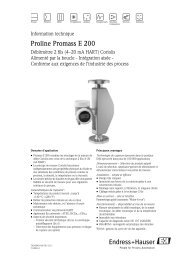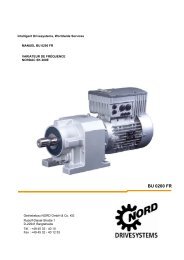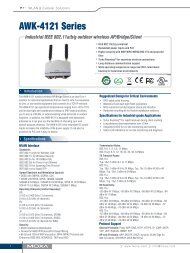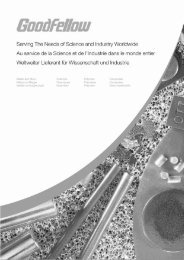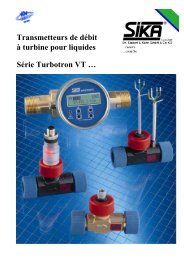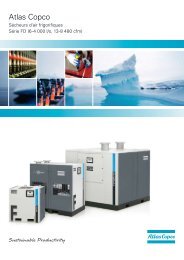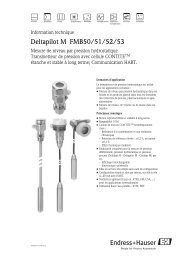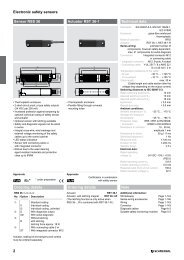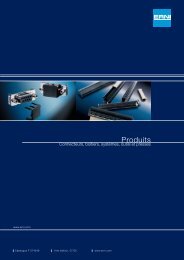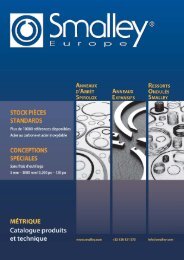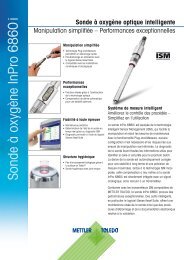Flexible Heaters Design Guide - BiS Sistem
Flexible Heaters Design Guide - BiS Sistem
Flexible Heaters Design Guide - BiS Sistem
You also want an ePaper? Increase the reach of your titles
YUMPU automatically turns print PDFs into web optimized ePapers that Google loves.
Examples of Thermal Systems<br />
Introduction <strong>Design</strong><br />
<strong>Guide</strong><br />
Polyimide<br />
<strong>Heaters</strong><br />
Silicone<br />
Rubber<br />
<strong>Heaters</strong> (foil)<br />
Standard<br />
Polyimide<br />
& Rubber<br />
Rubber<br />
<strong>Heaters</strong><br />
(wire-wound)<br />
Mica <strong>Heaters</strong> Thermal-Clear<br />
<strong>Heaters</strong><br />
All-Polyimide<br />
<strong>Heaters</strong><br />
Sensors,<br />
Controllers &<br />
Accessories<br />
Description of<br />
Thermal System<br />
Wattage<br />
requirements<br />
Electrical<br />
parameters<br />
Heater<br />
selection<br />
Heat a tank containing 2 kg of chemical<br />
solution from 20°C to 50°C in 10<br />
minutes. The space available for<br />
mounting the heater is 4" × 5" (102 x<br />
127 mm). Input voltage is 120 VAC.<br />
From Thermal Calc*, we need 450 watts<br />
minimum for warmup plus losses.<br />
Heat moving film in a thermal processor.<br />
A sheet of polyester film weighing<br />
5 g must be brought from 25°C to<br />
90°C every 2 seconds. The heater will<br />
measure 2" × 12" (51 x 305 mm) and<br />
will be mounted on a metal platen.<br />
Input voltage is 120 VAC.<br />
From Thermal Calc*, we need 275 watts<br />
minimum for warmup plus losses.<br />
An LCD heater must be capable of<br />
bringing the 6" × 8" (152 X 203 mm)<br />
display from-55°C to 0°C in 5 minutes<br />
and maintaining it there.<br />
Input voltage is 120 VDC.<br />
From Thermal Calc*, we need 50 watts<br />
for warmup and 20 watts for maintenance<br />
of temperature.<br />
R = E²/W = 120²/450 = 32 Ω R = E²/W = 120²/275 = 52 Ω R = E²/W = 28²/50 = 16 Ω<br />
Choosing polyimide for chemical resistance,<br />
the best choice is<br />
HK5490R27.7L12E<br />
Specifying silicone rubber for lower<br />
cost, the best choice is<br />
HR5433R44.1L12A<br />
From Minco’s standard Thermal-Clear<br />
heaters we choose model<br />
H6709R14.8L12B<br />
Actual wattage Wattage is 120²/27.7 = 520 W Wattage is 120²/44.1 = 327 W Wattage is 28²/14.8 = 53 W<br />
Watt density Watt density = W/effective area =<br />
520/17.74 in² = 29 W/in² (4.5 W/cm²)<br />
Installation From watt density charts we specify<br />
Acrylic PSA with aluminum backing (E<br />
option). This is rated to 31 W/in² (4.8<br />
W/cm²) at 50°C.<br />
Leadwire<br />
current<br />
Control<br />
Sensor<br />
Custom<br />
options<br />
AWG 24 leadwire current rating is 7.5 A.<br />
Actual current is:<br />
I = 120/27.7 = 4.3 A (OK).<br />
The CT16A controller with optional<br />
AC744 solid state relay will handle the<br />
current.<br />
An S665 Thermal-Tab RTD will be<br />
mounted to the side of the tank.<br />
An AP heater would provide a higher<br />
watt density for faster warmup (at<br />
higher cost). A rubber or mica heater<br />
would allow more watts for faster<br />
warmup, if acceptable in the application.<br />
Watt density = W/effective area =<br />
327/21.80 in² = 15 W/in² (2.3 W/cm²)<br />
Any type of heater mounting will handle<br />
the watt density. We will factory<br />
vulcanize the heater for lowest installed<br />
cost.<br />
AWG 24 leadwire current rating is 7.5 A.<br />
Actual current is:<br />
I = 120/44.1 = 2.7 A (OK).<br />
The customer integrates a custom controller<br />
into other electronic circuits.<br />
An S247 thin-film RTD will be potted<br />
into a hole in the platen. A thermostat<br />
with 100°C setpoint will provide<br />
overtemperature shutoff.<br />
The sensor and thermostat could be<br />
integrated into the heater.<br />
Watt density = W/effective area =<br />
53/48 in² = 1.1 W/in² (0.2 W/cm²)<br />
We choose Acrylic PSA backing for<br />
convenience (B option). The watt density<br />
is well within the rated maximum.<br />
AWG 30 leadwire current rating is 3 A.<br />
Actual current is:<br />
I = 28/14.8 = 1.9 A (OK).<br />
A CT198-1005 <strong>Heaters</strong>tat will control<br />
the heater. Its setpoint will be<br />
adjustable from 6 to 62°C. We have<br />
chosen a model with a higher range in<br />
order to ensure that the LCD itself<br />
reaches 0°C. We know the setpoint will<br />
have to be higher because it controls<br />
the heater element which runs hotter<br />
than the surface beneath it.<br />
None: The heater acts as the sensor!<br />
Placing the lead connections on an<br />
external tab would remove the lead<br />
bulge from the display area. Switching<br />
to a sensor and CT325 for control,<br />
instead of the <strong>Heaters</strong>tat, would allow<br />
higher wattage and finer control.<br />
Reference<br />
*Thermal Calc is an on-line tool available at www.minco.com/e2e to assist in estimating heater wattage requirements from known<br />
parameters.<br />
14<br />
Sal es and Support<br />
|<br />
Americas: 763.571.3121 | Europe: (33) 5 61 03 24 01 | Asia Pacific: (65) 6511 3388





